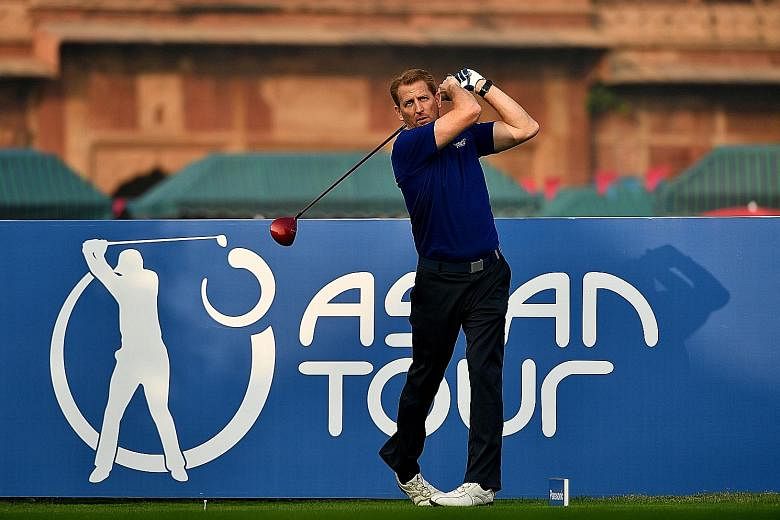The burgeoning partnership between Asia's and Europe's main golf circuits is a win-win opportunity for both, but the Asian Tour's newly-appointed chief executive Josh Burack stressed that it will not lead to an eventual merger.
A planned union had been mooted in August 2014 before objections from Asian Tour players scuppered it. Talks resumed and led to the signing of a formal tie-up last July.
"This is a great opportunity for us to add more tournaments to our schedule and enhance opportunities for our players," he told The Straits Times.
"But this strategic alliance is as far as it goes. There are no plans for us to merge in the future. Each side wants to retain its own identity."
This was the 46-year-old American's first interview with the Singapore media since he was hired to helm the Singapore-headquartered Asian Tour in October.
Among his chief priorities ahead of the upcoming season, which starts with next week's SMBC Singapore Open, is to leverage on the new deal with the European Tour and encourage new co-sanctioned tournaments. The Philippine Masters will make its debut next year and is an example of this new collaboration.
-
14
Asian golfers ranked in the top 100. That is more than Africa (five), Australia (four) and South America (three) combined.
10
Asian Tour strokeplay events (out of 23) in 2016 were hosted in South-east Asia.
+5.1%
Worldwide spending on golf was expected to hit US$1.82 billion (S$2.59 billion) in 2016. This includes sponsorship of professional and amateur sanctioning bodies and tournaments, charity fundraisers, endorsement deals and corporate hospitality.
There were seven Asian and European Tour co-sanctioned events last year, down from the peak of nine in 2007, and Burack said: "Given their proximity to us, we can do more with the Japan Golf Tour Organisation, the Australian Tour and the Sunshine Tour."
This will increase prize money, which has dropped since the Tour's heyday. In 2008, the Asian Tour had 31 events - excluding the four Majors and four World Golf Championships (WGC) - with about US$45 million (S$64 million) on offer.
In 2015, there were 20 events with a combined US$28.88 million. Last year, it went up to 23 events (excluding the US$4.8 million EurAsia Cup, a matchplay team event) and US$33.77 million.
The Asian Tour's coverage is televised to about 750 million households in 180 countries and its tournaments last year were held in 15 Asian countries and territories.
Yet critics argue that this exaggerates the value of its reach. Last year, 10 of the 23 events were hosted in South-east Asia, with five more in the game's East Asia stronghold of Japan and South Korea.
Burack said: "The goal is to have one of our events in every single market in Asia, but that takes time. Staging a golf tournament requires a lot of resources."
Ominously, the juggernaut United States-based PGA Tour, whose 2017 purse will offer a staggering US$339 million, has made inroads into Asia in recent years.
The development circuit PGA Tour China was established in 2014 and it has a lucrative Asian Swing; the CIMB Classic (Malaysia), the WGC-HSBC Champions (China) and CJ Cup (South Korea) offer nearly a combined US$26 million.
Having met his PGA Tour counterparts, Burack was not worried though. He said: "I don't believe they have a vision to come and conquer Asia. They're limited by their schedule, which is very packed ."
He did concede the need to increase engagement with China, a huge but unpredictable market due to the government's changeable policies towards golf.
The Asian Tour had six tournaments in China in 2008 but just one last year. Burack said: "I'm optimistic we'll be back there in a bigger way in the future."
Despite golf's global participation rates dropping amid competition from trendy sports like cycling and mixed martial arts, worldwide spending on the sport, according to IEG research, was expected to hit US$1.82 billion last year, up 5.1 per cent from 2015.
James Walton, head of the sports business service line at Deloitte Singapore and South-east Asia, said: "Golf in Asia may not be the untapped market some make it out to be but certainly there is potential here."
The on-course talent is also progressing. Led by multiple PGA Tour winner and world No. 6 Hideki Matsuyama, there are 14 Asian golfers ranked in the top 100. That is more than Africa (five), Australia (four) and South America (three) combined.
Talent retention on the Asian Tour is a tricky business though, noted Walton.
"It is still seen as a stepping stone to the bigger tours for the players who become world class," he said. "But that's a fact of life that affects other sports too. The elite baseballers and basketballers tend to leave Japan and China for the US."
Fortunately for Burack, the likes of established stars Thongchai Jaidee, Anirban Lahiri and K.J. Choi have not forgotten their roots and do return to play in Asian Tour events.
Burack said: "The long-term goal is to have a schedule with 48 to 50 events a year. That is hard but something we want to work towards...
"Our mission has always been to create more and more playing opportunities for our members and keep our identity as a fully fledged independent organisation."
•The Business of Sport is a monthly series that explores the current trends and talking points of the emerging sport industry.


